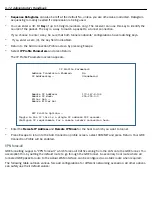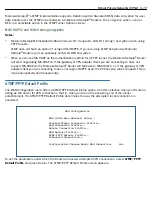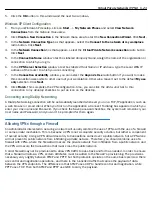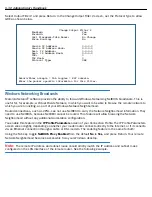
Virtual Private Networks (VPNs) 5-23
5.
Click the
OK
button in this window and the next two windows.
Windows XP Client Configuration
1.
From your Windows XP desktop, click on
Start
--->
My Network Places
and select
View Network
Connections
from the
Network Tasks
area.
2.
Click
Create a New Connection
in the
Network Tasks
area to star t the
New Connection Wizard
. Click
Next
.
3.
In the
Network Connection Type
box that appears, select the
Connect to the network at my workplace
radio button. Click
Next
.
4.
In the
Network Connection
box that appears, select the
Virtual Private Network connection
radio button.
Click
Next
.
5.
In the
Connection Name
window's text box labeled
Company Name
, assign the name of the organization or
connection to which you log in.
6.
In the
VPN Server Selection
window's text box labeled
Host Name or IP address
, type the Local WAN IP
address of the router to which you are connecting.
7.
In the
Connection Availability
window, you can select the
Anyone's Use
radio button if you want to make
this connection accessible to other users of your workstation. Other wise, leave it set to the default
My use
only
selection. Click
Next
.
8.
Click
Finish
. This completes the VPN configuration. Also, you can click the
Add a shor tcut
to this
connection to my desktop
checkbox to put an icon on the desktop.
Connecting using Dial-Up Networking
A Dial-Up Networking connection will be automatically launched whenever you run a TCP/IP application, such as
a web browser or email client. When you first run the application a Connect To dialog box appears in which you
enter your User name and Password. If you check the Save password checkbox, the system will remember your
User name and Password, and you won’t be prompted for them again.
Allowing VPNs through a Firewall
An administrator interested in securing a network will usually combine the use of VPNs with the use of a firewall
or some similar mechanism. This is because a VPN is not a complete security solution, but rather a component
of overall security. Using a VPN will add security to transactions carried over a public network, but a VPN alone
will not prevent a public network from infiltrating a private network. Therefore, you should combine use of a
firewall with VPNs, where the firewall will secure the private network from infiltration from a public network, and
the VPN will secure the transactions that must cross the public network.
A strict firewall may not be provisioned to allow VPN traffic to pass back and for th as needed. In order to ensure
that a firewall will allow a VPN, cer tain attributes must be added to the firewall's provisioning. The provisions
necessar y var y slightly between ATMP and PPTP, but both protocols operate on the same basic premise: there
are control and negotiation operations, and there is the tunnelled traffic that carries the payload of data
between the VPN endpoints. The difference is that ATMP uses UDP to handle control and negotiation, while
PPTP uses TCP. Then both ATMP and PPTP use GRE to carr y the payload.
Содержание Netopia Embedded Software
Страница 1: ...Administrator s Handbook Motorola Netopia Embedded Seftware Version 8 7 4 Enterprise Series Routers ...
Страница 10: ...x Administrator s Handbook ...
Страница 16: ...1 6 Administrator s Handbook ...
Страница 44: ...2 28 Administrator s Handbook ...
Страница 108: ...3 64 Administrator s Handbook ...
Страница 176: ...5 34 Administrator s Handbook ...
Страница 202: ...6 26 Administrator s Handbook ...
Страница 243: ...IP Setup 7 41 Additional LAN Configuration Name IP Address Additional LAN 1 1 1 1 1 Additional LAN 2 0 0 0 0 ...
Страница 244: ...7 42 Administrator s Handbook ...
Страница 340: ...Index 6 ...






























